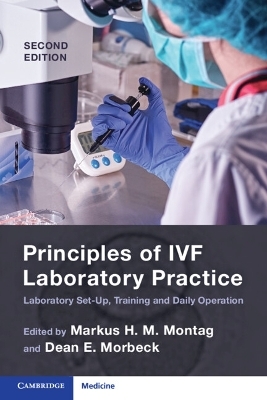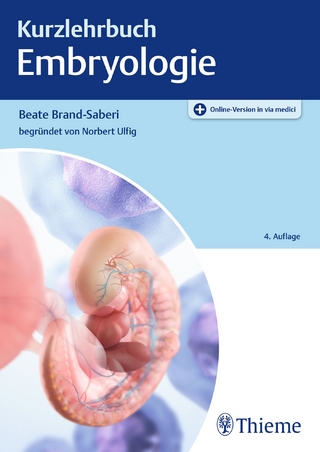
Principles of IVF Laboratory Practice
Cambridge University Press (Verlag)
978-1-009-01580-6 (ISBN)
In-vitro fertilization (IVF) is a procedure practised worldwide, with patients and practitioners expecting higher live birth rates and excellent standards of quality as methodologies become more established. This practical book covers every stage in the life of an IVF laboratory, from designing and planning the laboratory to training the embryologists and ongoing management and troubleshooting, providing step-by-step protocols for today's best practice. Chapters follow the same structure, allowing readers to translate complex and specialized procedures into a standard workflow. Several new chapters are included in this second edition, including descriptions of the protocol for piezo-ICSI, safe and effective cryostorage of embryos, and how to manage emergency situations in the IVF laboratory. Written by an international team of experts, this is an exemplary portfolio of techniques, providing a good foundation of working practice for both new and experienced embryologists.
Markus H. M. Montag started his career in IVF as post-doc in the team of Prof SC Ng, the father of the first subzonal insemination (SUZI) baby at the National University Hospital Singapore. From 1993 to 2013 he was laboratory director in a private IVF unit and at the Universities of Bonn and Heidelberg. He is currently the CEO of ilabcomm GmbH, his IVF consultancy company. Dean E. Morbeck is the Chief Scientific Officer for Kindbody Inc in New York City. He most recently served as Scientific Director at Fertility Associates New Zealand and Sunfert International Fertility Centre, Malaysia, and is an Adjunct Associate Professor in the Department of Obstetrics and Gynecology at Monash University. Prior to moving to New Zealand, Dr. Morbeck was an Associate Professor at the Mayo Clinic.
The evolution of IVF practice; Section I. Starting a New Laboratory & Training Protocols: 1. Establishing and equipping a new IVF laboratory; 2. Basic embryology skills and responsibilities in the IVF laboratory; 3. Sperm preparation for IVF: training protocol; 4. Oocyte pick-up for IVF: training protocol; 5. Embryologist training: embryo transfer; 6. ICSI for IVF: training protocol; 7. Embryo assisted hatching for IVF: training protocol and method; 8. Embryo biospy for IVF: training protocol; 9. Vitrification for IVF: training protocol; 10. Mouse embryo assay for quality control in the IVF laboratory; 11. Sperm survival assay for quality control in the IVF laboratory; Section II. Pre-Procedure Protocols: 12. Quality control in the IVF laboratory: continuous improvement; 13. Setup procedures for optimizing performance in the IVF laboratory; Section III. Gametes: 14. Sperm preparation for therapeutic IVF; 15. Processing surgically retrieved sperm in the IVF laboratory; 16. Cryopreservation of sperm for IVF: semen samples and individual sperm; 17. Oocyte collection for IVF; 18. In-vitro maturation of immature oocytes for IVM-IVF; 19. Oocyte grading by morphological evaluation; 20. Vitrification of oocytes for IVF; Section IV. Insemination/ICSI: 21. General insemination for IVF; 22. Conventional IVF with short co-incubation; 23. Technical aspects of ICSI for ejaculated spermatozoa; 24. Set-up and adapted protocol for piezo-ICSI; 25. Sperm selection for ICSI by morphology: MSOME/IMSI; 26. Sperm selection for ICSI by viability; 27. Artificial oocyte activation for IVF; Section V. Fertilization Assessmant: 28. Fertilization assessment in IVF and ICSI; 29. Polar body biopsy for IVF; 30. Zygote cryopreservation for IVF; Section VI. Embryo Assessment – Morphology & Beyond: 31. Embryo assessment at the pre-compaction stage in the IVF laboratory; 32. Embryo assessment in the post-compaction stage in the IVF laboratory; 33. Embryo assessment at the blastocyst stage in the IVF laboratory; 34. Trophectoderm biopsy for preimplantation genetic testing; 35. Embryo culture by Time-lapse: selection and beyond; Section VII. Embryo Cryopreservation: 36. Cryopreservation of pre-compaction embryos for IVF; 37. Cryopreservation of post-compaction embryos for IVF; 38. Safe and effective cryostorage of embryos for IVF; Section VIII. Embryo Transfer: 39. Routine embryo transfer in the IVF laboratory; Section IX. Quality Management: 40. Verification of specimen identity by double checking with a witness; 41. Quality management in the IVF laboratory: quality improvement, document and process control and adverse events; 42. Trouble-shooting in the IVF laboratory; 43. Disaster preparedness in the IVF Laboratory.
| Erscheinungsdatum | 25.08.2023 |
|---|---|
| Zusatzinfo | Worked examples or Exercises |
| Verlagsort | Cambridge |
| Sprache | englisch |
| Maße | 156 x 234 mm |
| Gewicht | 610 g |
| Themenwelt | Medizin / Pharmazie ► Medizinische Fachgebiete ► Gynäkologie / Geburtshilfe |
| Studium ► 1. Studienabschnitt (Vorklinik) ► Histologie / Embryologie | |
| ISBN-10 | 1-009-01580-X / 100901580X |
| ISBN-13 | 978-1-009-01580-6 / 9781009015806 |
| Zustand | Neuware |
| Informationen gemäß Produktsicherheitsverordnung (GPSR) | |
| Haben Sie eine Frage zum Produkt? |
aus dem Bereich


